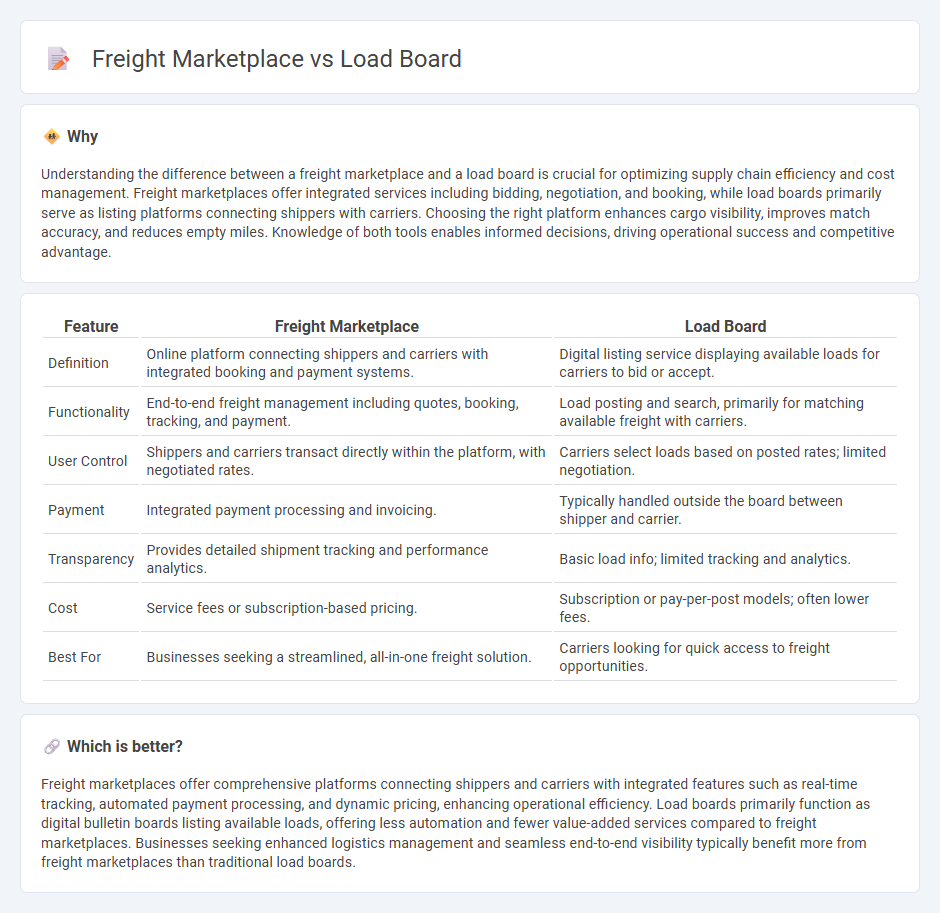
Freight marketplaces connect shippers and carriers through comprehensive digital platforms that facilitate real-time negotiations, optimized route planning, and transparent pricing, enhancing overall supply chain efficiency. Load boards display available freight loads for carriers to browse and accept, primarily focusing on matching shipments with transportation capacity quickly but with less dynamic pricing and negotiation features. Explore the differences between freight marketplaces and load boards to choose the best solution for your logistics needs.
Why it is important
Understanding the difference between a freight marketplace and a load board is crucial for optimizing supply chain efficiency and cost management. Freight marketplaces offer integrated services including bidding, negotiation, and booking, while load boards primarily serve as listing platforms connecting shippers with carriers. Choosing the right platform enhances cargo visibility, improves match accuracy, and reduces empty miles. Knowledge of both tools enables informed decisions, driving operational success and competitive advantage.
Comparison Table
| Feature | Freight Marketplace | Load Board |
|---|---|---|
| Definition | Online platform connecting shippers and carriers with integrated booking and payment systems. | Digital listing service displaying available loads for carriers to bid or accept. |
| Functionality | End-to-end freight management including quotes, booking, tracking, and payment. | Load posting and search, primarily for matching available freight with carriers. |
| User Control | Shippers and carriers transact directly within the platform, with negotiated rates. | Carriers select loads based on posted rates; limited negotiation. |
| Payment | Integrated payment processing and invoicing. | Typically handled outside the board between shipper and carrier. |
| Transparency | Provides detailed shipment tracking and performance analytics. | Basic load info; limited tracking and analytics. |
| Cost | Service fees or subscription-based pricing. | Subscription or pay-per-post models; often lower fees. |
| Best For | Businesses seeking a streamlined, all-in-one freight solution. | Carriers looking for quick access to freight opportunities. |
Which is better?
Freight marketplaces offer comprehensive platforms connecting shippers and carriers with integrated features such as real-time tracking, automated payment processing, and dynamic pricing, enhancing operational efficiency. Load boards primarily function as digital bulletin boards listing available loads, offering less automation and fewer value-added services compared to freight marketplaces. Businesses seeking enhanced logistics management and seamless end-to-end visibility typically benefit more from freight marketplaces than traditional load boards.
Connection
Freight marketplaces connect shippers with carriers by providing a centralized platform where load boards list available shipments and trucks in real time. Load boards serve as digital marketplaces within the freight ecosystem, enabling efficient matching of freight loads with suitable carriers based on location, capacity, and delivery requirements. This integration enhances visibility, reduces empty miles, and optimizes supply chain logistics through streamlined communication and transaction processing.
Key Terms
Carrier Matching
Load boards connect carriers directly with available freight loads by listing shipment details and enabling quick bookings based on real-time capacity and route compatibility. Freight marketplaces offer a more integrated approach by combining load postings with advanced algorithms that optimize carrier matching through historical performance data, rates, and carrier preferences. Explore how each platform enhances carrier efficiency and profitability to choose the best fit for your logistics needs.
Freight Listings
Freight listings on load boards are typically standardized and categorized by shipment type, route, and equipment needs, providing quick access to available loads for carriers. Freight marketplaces enhance these listings by integrating more dynamic features such as real-time bidding, comprehensive carrier profiles, and advanced matching algorithms that streamline the negotiation and booking process. Explore how these tools optimize freight listing management and boost operational efficiency.
Real-Time Bidding
Load boards and freight marketplaces differ significantly in their approach to Real-Time Bidding (RTB). Load boards typically offer static listings where shippers and carriers manually negotiate rates, while freight marketplaces implement dynamic RTB systems that enable instantaneous bids, optimizing pricing and capacity utilization. Explore how Real-Time Bidding revolutionizes freight matching efficiency by diving deeper into the latest marketplace technologies.
Source and External Links
123Loadboard - A leading load board platform offering web and mobile solutions for truckers to find truck loads, backhauls, and offers tools like trip planning, mileage routing, credit checks, and quick pay options.
Shiply Load Board - A free load board where drivers can bid on various transport jobs ranging from single boxes to full truckloads, allowing flexible matching of freight to available vehicles along planned routes.
Truckstop Load Board - A premium load board platform providing features like instant booking, high-quality load listings, carrier verification, and integration tools that enhance freight booking efficiency and safety from fraud.
 dowidth.com
dowidth.com